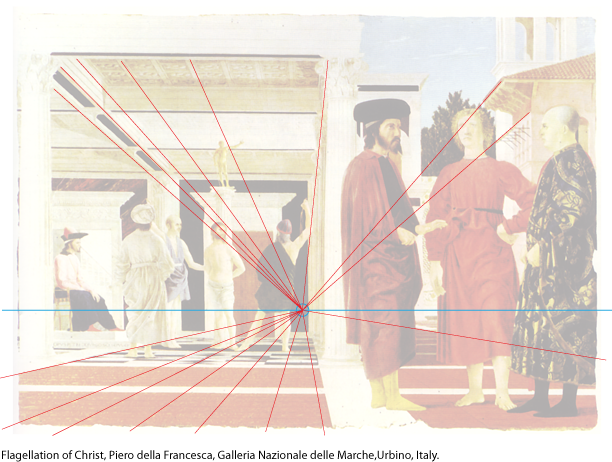Week 2: Math + Art
Throughout history, art and math have been connected in a dynamic, enduring relationship, demonstrating how mathematics has profoundly influenced art. Mathematics has provided a language and framework that artist utilize to create, analyze, and understand the visual elements of their work. Professor Vesna’s lecture underscores the significance of Piero Della Francesca as one of the leading artistic mathematicians. She states Piero della Francesca focused on “...studying the geometry of vision” commonly referred to as perspective (Vesna 18:35). In J.V. Field’s book “Piero Della Francesca. A Mathematician Artist,” he states “Perspective was a form of study in which it was acknowledged as legitimate to use mathematics in the pursuit of natural philosophy” (Feild 376). In other words, this quote suggests that perspective was recognized as an approved area where mathematics could be applied to strengthen understanding and observation of the natural world.
.jpg!Large.jpg)
One of Francesca’s most renowned works “The Flagellation of Christ,” embodies his true knowledge and mastery of precise perspective. While this piece is rather small standing at only 58.4cm x 81.5cm, many can agree that Francesca’s meticulous calculations and careful composition create a sense of dimensionality that transcends the boundaries of art at the time (Zappella 1).
Francesca utilizes math techniques, particularly geometry, to meticulously depict forms and proportions. Francesca creates a masterful demonstration of perspective and spatial depth by applying knowledge of vanishing points, changes in scale, and geometrical placement of elements (Weigh 1). In addition, using the linear perspective technique, Francesca constructed the architectural elements of the background such as the courtyard and the columns (Molosso). This creates the illusion of space, drawing the audience's eye into the scene and enhancing the realism of the composition.

By levering geometry and precise calculations, Francesca achieved a level of realism and spatial depth that transcended previous notions of art at its time. Francesca is an artist that showcases the enduring relationship between art and mathematics.
Works Cited
Feild, J.V. Piero Della Francesca. A Mathematician’s Art, Yale University Press, 2005,
www.ams.org/notices/200703/rev-emmer.pdf.
Molosso. “The Flagellation of Christ, c.1445 - 1450 - Piero Della Francesca.” Www.Wikiart.Org, 28 Dec.
2013,
www.wikiart.org/en/piero-della-francesca/the-flagellation-of-christ-1450-1#:~:text=The%20painti
ng%20illustrates%20the%20flagellation,the%20foreground%20of%20the%20painting.
Sciendi, Amor. “The Flagellation of Christ: A Formal Analysis | Amorsciendi.” YouTube, YouTube, 12
July 2022, www.youtube.com/watch?v=0UfYuhnBdb4.
Vesna, Victoria. “Mathematics | Perspective | Time | Space” YouTube, YouTube, 9 Apr. 2012,
https://www.youtube.com/watch? v=GUr4xxZ_0gw&t=447s.
Weigh, Kim. Piero Della Francesca – “The Flagellation of Christ” - A Visual Review, 28 May 2013,
kimweigh.wordpress.com/about/references/.
Zappella, Christine, and Christine Zappella. “Piero Della Francesca, Flagellation of Christ.” Smarthistory
Piero Della Francesca Flagellation of Christ Comments,
smarthistory.org/piero-della-francescas-flagellation-of-christ/#:~:text=The%20subject%20of%20t
he%20Flagellation,Quattrocento%20(fifteenth%20century)%20painting. Accessed 8 Apr. 2024.

Hi Mallory, I liked learning about the artist Francesca, as this is the first time I've heard of his work. You made it clear that Francesca's use of math in "The Flagellation of Christ" shows how art and math have always influenced each other. I agree that by applying principles like perspective and geometry, he didn't just create a beautiful piece, but also pushed the boundaries of what art could achieve with math's help.
ReplyDeleteHi Mallory, I really liked learning about your analysis of Francesca's work and how artists from even the past have used mathematics within arts in innovative ways to incorporate different elements into their work. I also found it so interesting that mathematics utilized perspective to study philosophy!
ReplyDeleteHi Mallory, I loved your connection that mathematics has provided a language for artists to create, analyze, and understand their work. I agree, that Francesca does a great job of perception in his paintings. Your explanation of the linear perspective technique, helps us understand the background and how they work. The video and the figure of the center point helped support your claim. Overall, great job!!
ReplyDelete